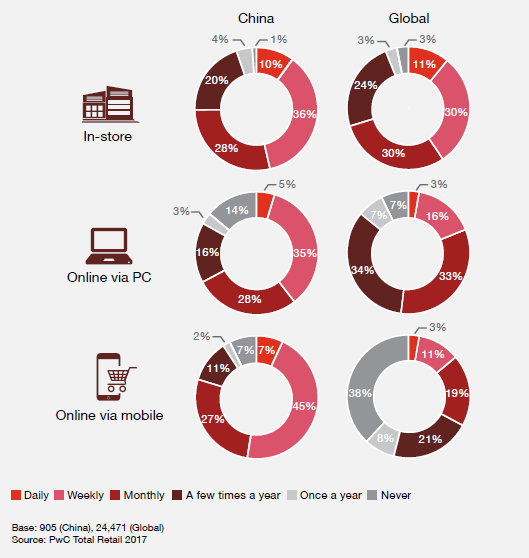To those who want to be eCommerce leaders: learn from Chinese brands. The future is already here.
Social and technological changes already pushed Chinese market a few steps ahead of Europe and the US. The future we believed in here, is already the past there. We learn that with each visit to China. This market is dynamic, fast-growing and always surprising. China’s market is setting the trends for global eCommerce. Here are our observations.
Chinese eCommerce
Chinese national online retail sales of goods and services reached up to 220 billion USD (1.40 trillion yuan) in Q1 2017. The market’s dynamics forces retailers and brands to innovate.
The key investment area in China for global retailers to thrive in the years to come is mobile eCommerce (mCommerce). In 2017, Chinese customers proved that they chose mobile shopping over in-store visits. Weekly, that’s over 52% of customers shopping on mobile vs 46% in-store shoppers in China. The expansion of shopping platforms might be responsible for this, but the success of Chinese eCommerce also lies in the growth of platform security and adapting to big data analytics.
Global shopping trends are following Chinese movements. However, there is a considerable gap to fill when it comes to learning from the Chinese.

Chinese mobile-first trends
There is no doubt that China is a mobile-centric nation. It is supported by innovative social eCommerce models (like shopping festivals and digital integration), and trusted digital payment infrastructure.
Here’s an interesting thing – a video showing successful models of Chinese eCommerce. It clearly shows that sellers are prepared for mobile users, but also the reveals differences in customers behavior. The majority of them looks for short and simple interactions. That’s why marketplaces are more lucrative than brand stores, selling platforms offer both products and services, and loyalty programs are replaced with discounts.
Easy mobile shopping
Chinese eCommerce happens mainly on mobile devices. The standard solution today is mobile apps that offer a vast variety of products in multiple categories, but Chinese eTailers are open to new solutions and adjust to their customers’ needs. Progressive web apps are seen as one of the future standards – with mobile-first approach they’re offering a super-fast user experience and entering the offline environment. PWAs are already available on the major selling platforms like Alibaba.
Marketplaces focus
Instead of building their own online shop, Chinese brands consolidate in marketplaces. These selling platforms present extensive offers of products and complete information about them. You can find offers from all imaginable sellers – starting from small local food shops that deliver fresh products quickly, and ending with the biggest brands sending products worldwide.
Services + marketplaces
Marketplaces are open for all products, but also services. Looking for tickets to the cinema or a concert, ordering food, travel services – that’s all in one place. What’s more, this includes chosen governmental services like applying for a visa.
Instant discounts
Loyalty seems to be a long-term engagement for Chinese customers. Instead of building loyalty programs, brands offer discounts instantly after buying a product or service.
Key players on Chinese eCommerce
In China, brands entering the online markets are smart. They don’t waste energy on creating individual shops and inviting customers anew. In place of that, they’re using online marketplaces that are simple and user-friendly. Chinese eCommerce is focused on a few key players, like Taobao, JD, Tmall, and Aliexpress which, together, serve the majority of Chinese customers.
Such an approach allows marketplace owners to spend more time on learning user behaviors and building innovations. This includes building offline experiences for customers and widening the eCommerce world with super-fast progressive web apps or in-store mobile shopping in a New Retail concept.
Published June 14, 2018











